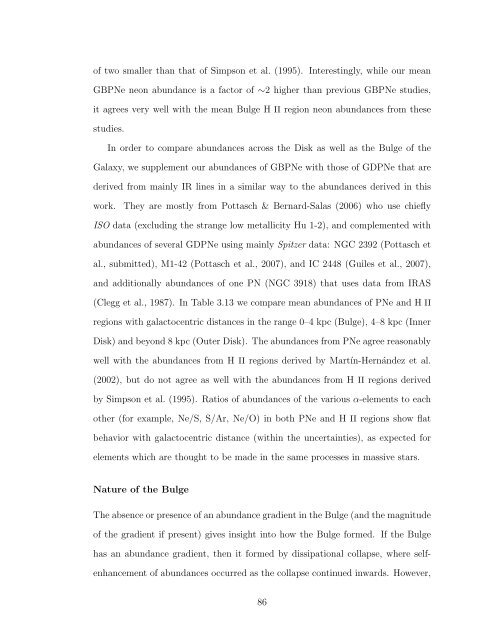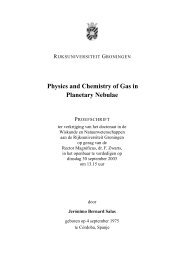TRACING ABUNDANCES IN GALAXIES WITH THE SPITZER ...
TRACING ABUNDANCES IN GALAXIES WITH THE SPITZER ...
TRACING ABUNDANCES IN GALAXIES WITH THE SPITZER ...
You also want an ePaper? Increase the reach of your titles
YUMPU automatically turns print PDFs into web optimized ePapers that Google loves.
of two smaller than that of Simpson et al. (1995). Interestingly, while our mean<br />
GBPNe neon abundance is a factor of ∼2 higher than previous GBPNe studies,<br />
it agrees very well with the mean Bulge H II region neon abundances from these<br />
studies.<br />
In order to compare abundances across the Disk as well as the Bulge of the<br />
Galaxy, we supplement our abundances of GBPNe with those of GDPNe that are<br />
derived from mainly IR lines in a similar way to the abundances derived in this<br />
work. They are mostly from Pottasch & Bernard-Salas (2006) who use chiefly<br />
ISO data (excluding the strange low metallicity Hu 1-2), and complemented with<br />
abundances of several GDPNe using mainly Spitzer data: NGC 2392 (Pottasch et<br />
al., submitted), M1-42 (Pottasch et al., 2007), and IC 2448 (Guiles et al., 2007),<br />
and additionally abundances of one PN (NGC 3918) that uses data from IRAS<br />
(Clegg et al., 1987). In Table 3.13 we compare mean abundances of PNe and H II<br />
regions with galactocentric distances in the range 0–4 kpc (Bulge), 4–8 kpc (Inner<br />
Disk) and beyond 8 kpc (Outer Disk). The abundances from PNe agree reasonably<br />
well with the abundances from H II regions derived by Martín-Hernández et al.<br />
(2002), but do not agree as well with the abundances from H II regions derived<br />
by Simpson et al. (1995). Ratios of abundances of the various α-elements to each<br />
other (for example, Ne/S, S/Ar, Ne/O) in both PNe and H II regions show flat<br />
behavior with galactocentric distance (within the uncertainties), as expected for<br />
elements which are thought to be made in the same processes in massive stars.<br />
Nature of the Bulge<br />
The absence or presence of an abundance gradient in the Bulge (and the magnitude<br />
of the gradient if present) gives insight into how the Bulge formed. If the Bulge<br />
has an abundance gradient, then it formed by dissipational collapse, where self-<br />
enhancement of abundances occurred as the collapse continued inwards. However,<br />
86













